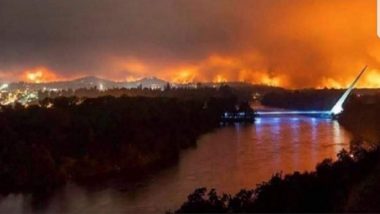The Carr Fire raging in Northern California has claimed six lives, including a firefighter and bulldozer operator working to extinguish the blaze. Shifting winds, dry fuel and steep terrain have helped the monstrous fire engulf almost 100,000 acres by Sunday night across California, authorities said.
The fire, which started a week ago, is only 17% contained, according to the California Department of Forestry and Fire Protection, known as Cal Fire. More than 3,300 fire personnel are battling the flames with more than 300 engines and 17 helicopters, Cal Fire reported.
It is one of eight major wildfires currently burning in the state.
Vast blazes claiming life and property has become an annual feature in the U.S.’ west coast. So why is California prone to such massive forest fires?
Climate:
Most of California is in a Mediterranean climate zone, characterized by virtually zero rainfall for half the year. This lets things dry out. A wet season before the usual summer drought also makes for even more dried-out vegetation.
This cycle repeats every year. This year ,"This fire was whipped up into a whirlwind of activity" by gale-force winds, California department of forestry and fire protection (CalFire) chief Ken Pimlott, "uprooting trees, moving vehicles, moving parts of roadways". He told reporters they were "seeing fire whirls - literally what can be described as a tornado".
Santa Ana Winds:
The Santa Ana winds are a common occurrence in Southern California between October and March as warm air blows in from the Mojave Desert leading to blustery days in the region. At their most powerful, the winds can wreck destruction throughout the region, knocking down trees and power lines. The wind’s heat also helps dry vegetation, making it easier to burn. And when there’s a fire, the winds can also transport flames quickly spreading fire from place to place.
2018:
Experts say this has been the worst start to the fire season in 10 years - partly due to the 2012-2017 drought that killed off large amounts of vegetation.
UCLA climate scientist Daniel Swain told the Los Angeles Times much of the state's vegetation had reached "explosively dry" levels.
The hot and dry weather in the region has also contributed to the rapid spread of California’s fires. 2017 was the second hottest on record when measured half way through the year. And downtown Los Angeles has received just 0.11 inches of rainfall since the beginning of October, typically the region’s wet season, according to data from the National Weather Service. This has led to the accumulation of factors that have made the state’s forest into dry kindling.
(The above story first appeared on LatestLY on Jul 30, 2018 09:20 PM IST. For more news and updates on politics, world, sports, entertainment and lifestyle, log on to our website latestly.com).













 Quickly
Quickly











